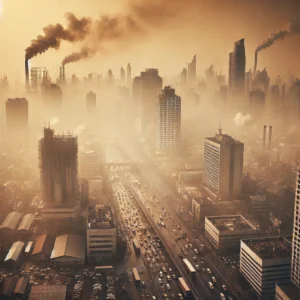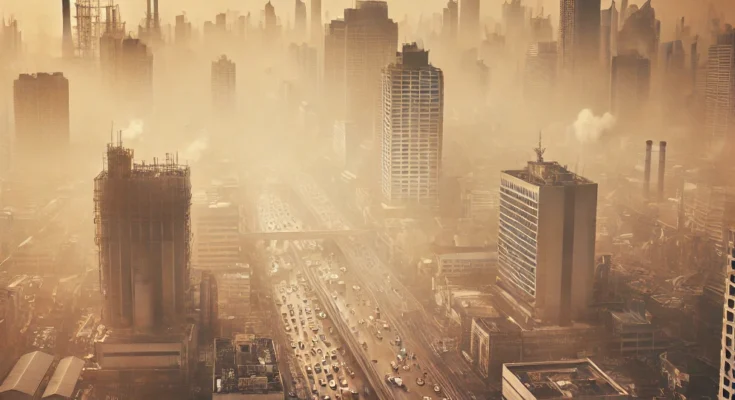Smog is a type of air pollution that makes the air look hazy or brownish, especially in cities. It can cause breathing problems, eye irritation, and even lead to serious health issues over time. Smog is primarily caused by emissions from vehicles, factories, and other pollutants reacting with sunlight.
Introduction
Smog, or “el smog” as it’s known in Spanish-speaking countries, is a thick, hazy air pollution layer that affects the quality of air we breathe, especially in big cities. It is harmful to our health, the environment, and even buildings! But what exactly is smog, how does it form, and how can we reduce it?

What is Smog? (¿Qué es el Smog?)
In simple terms, que es el smog? Smog is a combination of the words “smoke” and “fog.” It’s a type of air pollution that looks like a thick, brownish haze hanging in the sky. Smog mainly forms when pollutants, especially from vehicles and factories, react with sunlight. There are two main types of smog:
- Photochemical Smog: Created mainly by the reaction of sunlight with pollutants like nitrogen oxides and volatile organic compounds (VOCs).
- Sulfurous Smog: Formed from sulfur dioxide emissions, usually from coal-burning factories.
Causes of Smog
The main causes of smog are human activities, especially in urban areas. Here’s a closer look at the top causes:
- Vehicle Emissions: Cars, trucks, and buses emit pollutants like nitrogen oxides (NOx) and hydrocarbons. When these mix with sunlight, they form photochemical smog.
- Industrial Emissions: Factories and power plants release sulfur dioxide, nitrogen oxides, and other harmful pollutants.
- Burning of Fossil Fuels: Activities like burning coal and oil for energy produce high levels of sulfur dioxide and carbon monoxide, which contribute to smog.
- Agricultural Activities: Some fertilizers release ammonia, which can combine with other pollutants to form smog.
- Natural Causes: Wildfires and volcanic eruptions can also release large amounts of smoke and ash, contributing to smog in certain areas.
Effects of Smog on Health and the Environment
Smog doesn’t just make it harder to see the sky; it can seriously impact our health and the environment. Here’s how:
Health Effects
- Respiratory Issues: Smog can make it hard to breathe, especially for people with asthma or other lung conditions.
- Eye and Skin Irritation: Smog can cause burning eyes and irritated skin.
- Long-term Health Risks: Exposure to smog over time can lead to more serious conditions like lung cancer, heart disease, and even reduced life expectancy.
Environmental Effects
- Plant Damage: Smog can damage crops, trees, and other vegetation, leading to lower agricultural yields.
- Water and Soil Pollution: Pollutants in smog can settle on soil and water, harming plants and animals.
- Acid Rain: Sulfur dioxide in smog can lead to acid rain, which harms forests, lakes, and wildlife.
Prevention and Reduction of Smog
To reduce smog, we can make changes in our daily lives and encourage broader environmental policies. Here are some practical ways to prevent and reduce smog:
1. Use Public Transportation or Carpool
- Reducing the number of cars on the road decreases vehicle emissions.
2. Switch to Cleaner Energy
- Use renewable energy sources like solar and wind. They produce less pollution than fossil fuels.
3. Improve Industrial Regulations
- Factories should follow strict emission controls to minimize air pollution.
4. Maintain Your Vehicle
- Regularly servicing your car ensures that it runs cleanly and produces fewer pollutants.
5. Support Smog Checks
- In places like California, regular smog checks help keep car emissions in check.
6. Reduce, Reuse, Recycle
- Less waste means less burning of trash and fossil fuels, helping to keep the air cleaner.
FAQs on Smog
1. Why is smog more common in cities?
- Cities have a higher concentration of vehicles, factories, and people. Combined with sunlight and little airflow, these factors make smog more common.
2. Can smog occur in colder climates?
- Yes, smog can form in both hot and cold climates. However, photochemical smog is more common in warmer regions.
3. How can I check smog levels in my area?
- Many cities have air quality indexes (AQI) that provide daily updates on pollution levels, including smog.
4. Does smog only affect people with respiratory conditions?
- No, smog can affect everyone, although people with respiratory conditions or allergies may feel its effects more severely.
Conclusion
Smog is a serious problem that impacts our health, environment, and even daily lives. By understanding its causes and effects, we can all take steps to reduce smog and create a cleaner, healthier world. Even small changes-like using public transport, recycling, or supporting policies for cleaner energy-can make a big difference.



